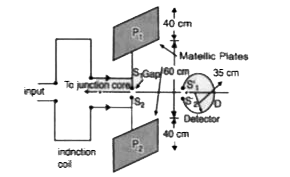Draw a labelled diagram of Hertz's experiment. Explain how electromagnetic radiations are produced using this set-up?Solution in Kannada
Hertz Experiment : Hertz.s experiment was based on the fact that an oscillating electric charge radiates electromagnetic waves and these waves carry energy which is being supplied at the cost of K.E. of the oscillating charge.
Hertz Apparatus : The experimental arrangement used by Hertz for the production and detection of electromagnetic waves in the laboratory, is shown in fig. His experimental arrangement consists of two metal sheets P1andP2. These sheets are connected to a source of very high voltage (ie, an induction coil, which can supply a potential difference of several thousand volts). S1andS2 are two metal spheres connected to the metal sheets P1andP2. The distance between the metal sheets is kept nearly 60 cm and that between the sphere is normally from 2 cm to 2.5 cm.
The two plates P1andP2 form a capacitor of very low capacitance (C). The circuit containing P1andP2 (being completed by conducting wire), has also some low value of inductance L. It thus forms an LC circuit. Detector (D) consisting of a coil to the ends of which two other small metal spheres S.1 and S.2 are connected.

Fig. : Schematic diagram of Hertz Experiment Working of Hertz apparatus : Due to existence of very high voltage, air present in the gap across the plates or spheres S1andS2 gets ionised. Due to presence of the ions or charged particles, the path between the spheres S1andS2 become conducting. As a result of this, very high time-varying current flows across the gap between S1andS2 (as plates P1andP2 form an LC circuit). Due to this a spark is produced. Since, sheets P1,P2 form an LC circuit, hence, electromagnetic waves of frequency f=12π√1LC are radiated .
Function of the detection D : Hertz detected the electromagnetic waves by means of a detector D, kept at suitable distance from the conducting spheres S11,S12 .Detector D is made of two similar conducting spheres S11 and S12 joined to the ends of a coil to form another LC circuit. The frequency of this LC circuit is made equal to the frequency of electromagnetic waves reaching it. The frequency can be adjusted by changing the diameter of the coil of the detector and by changing the distance between S.1andS.2. Hertz placed the detector in such a way that the magnetic lines of force produced by the oscillating electric field across the gap between S.1andS.2 are normal to the plane of coil (C). When magnetic lines of force cut the detector coil, an emf is induced in it. Hence, air in between the gap gets ionised. A conducting path becomes available for the induced current to flow across the gap. Thus, the spark is produced between S.1andS.2. Hertz also observed that the spark across the gap was the greatest when S.1S.2 were parallel to each other. This clearly established that electromagnetic waves produced were polarised i.e., →E and →B always lie in one plane.
Topper's Solved these Questions
- BOOK - OSWAAL PUBLICATIONCHAPTER - ELECTROMAGNETIC WAVESEXERCISE - TOPIC-2 : ELECTROMAGNETIC SPECTRUM (VERY SHORT ANSWER TYPE QUESTIONS)10videos
ELECTROMAGNETIC WAVES
- BOOK - OSWAAL PUBLICATIONCHAPTER - ELECTROMAGNETIC WAVESEXERCISE - TOPIC-2 : ELECTROMAGNETIC SPECTRUM (SHORT ANSWER TYPE QUESTIONS)7videos
ELECTROMAGNETIC WAVES
- BOOK - OSWAAL PUBLICATIONCHAPTER - ELECTROMAGNETIC WAVESEXERCISE - TOPIC-1 :DISPLACEMENT CURRENT ( SHORT ANSWER TYPE QUESTIONS)14videos
ELECTROMAGNETIC WAVES
- BOOK - OSWAAL PUBLICATIONCHAPTER - ELECTROMAGNETIC INDUCTION EXERCISE - TOPIC-2 (Eddy Current, Self & Mutual Inductance) (Numerical Problems)3videos
ELECTROMAGNETIC INDUCTION
- BOOK - OSWAAL PUBLICATIONCHAPTER - ELECTROSTATIC POTENTIAL AND CAPACITANCEEXERCISE - TOPIC -2 CAPACITORS AND CAPACITANCE (NUMERICAL PROBLEMS)8videos
ELECTROSTATIC POTENTIAL AND CAPACITANCE
Similar Questions
Name the electromagnetic radiations which are produced when high energy electrons are bombarded with metal target.
03:15View SolutionMention two applications of infrared radiation.
02:39View SolutionDisplacement current is given by,
05:36View SolutionA solenoid of length 1 m and 0.05 m diameter has 500 turns. If a current of 2A passes through the coil, calculate (i) the coefficient of self induction of the coil and (ii) the magnetic flux linked with the coil.
Data : l=1m,d=0.05m,r=0.025m,N=5000,I=2A,
(i) L=?(ii)ϕ=?01:17View SolutionTwo capacitors of capacitance 600 pF and 900 pF are connected in series across a 200 V supply. Calculate (i) the effective capacitance of the combination, (ii) the pd across each capacitor and (iii) the total charge stored in the system.
02:57View SolutionDraw and label the diagram of Electromagnetic induction
02:20View SolutionU - आकृति का विधुत चुम्बक किस प्रकार बनाया जा सकता है ? आरेख खींचकर समझाइए
04:53View SolutionDraw a labelled diagram of diagrammatic representation of Miller's experiment.
06:22View SolutionDraw a neat labelled diagram of neuron.
05:38View SolutionDraw neat and labelled diagrams for the following.
Electromagnetic Induction.04:53View SolutionDraw a neat labelled diagram of Miller's experiment
01:40View SolutionDraw a labeled diagram of Miller's experiment.
02:33View SolutionDraw a labelled diagram of a thermos flask. Explain how the transfer of heat by conduction, convection and radiation is reduced to a minimum in it.
03:26View SolutionDraw a diagram of Hertz experiment for producing electromagnetic wave.
02:20View SolutionDraw a neat labelled diagram of Rutherford's scattering experiment.
View Solution
